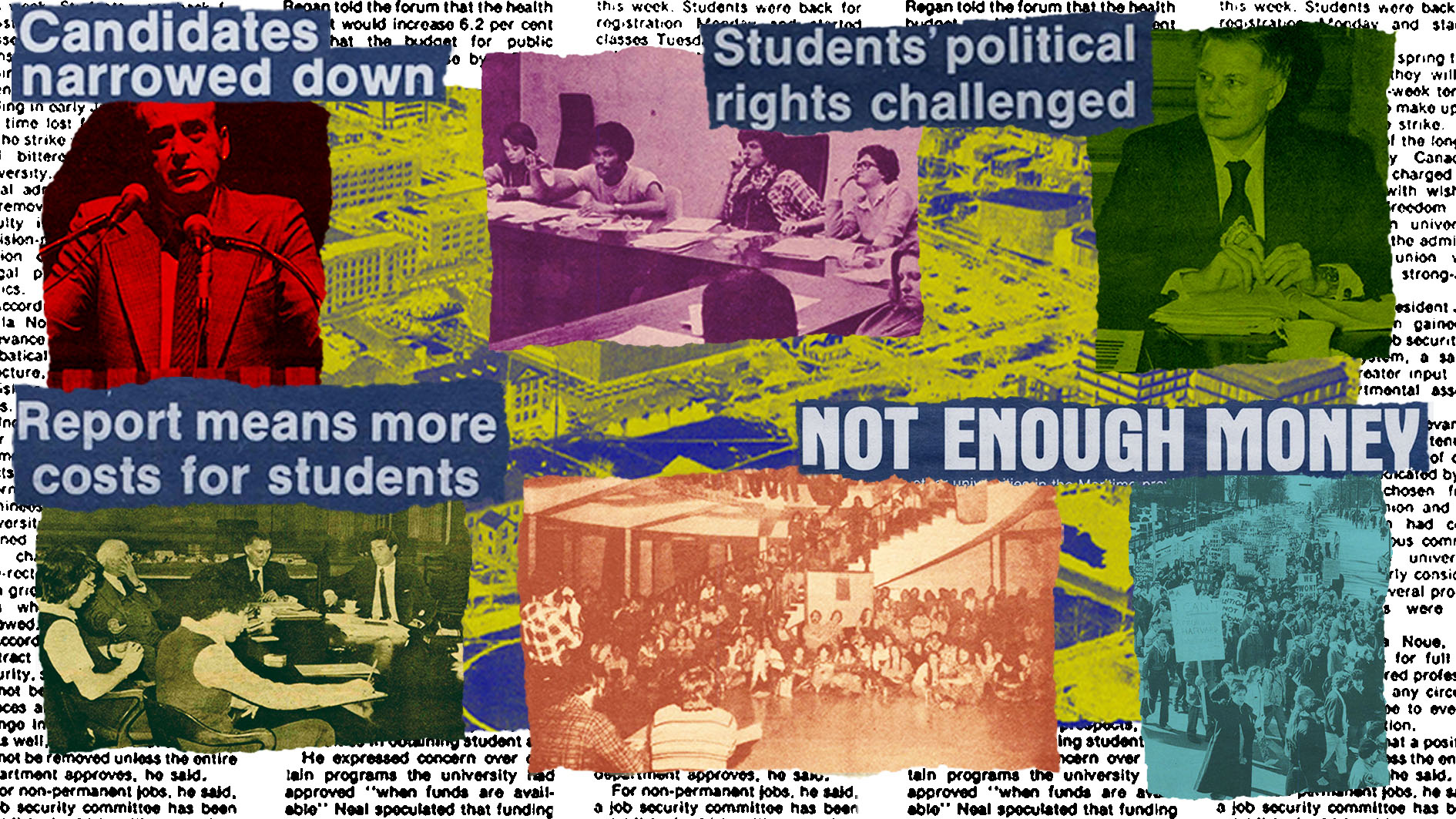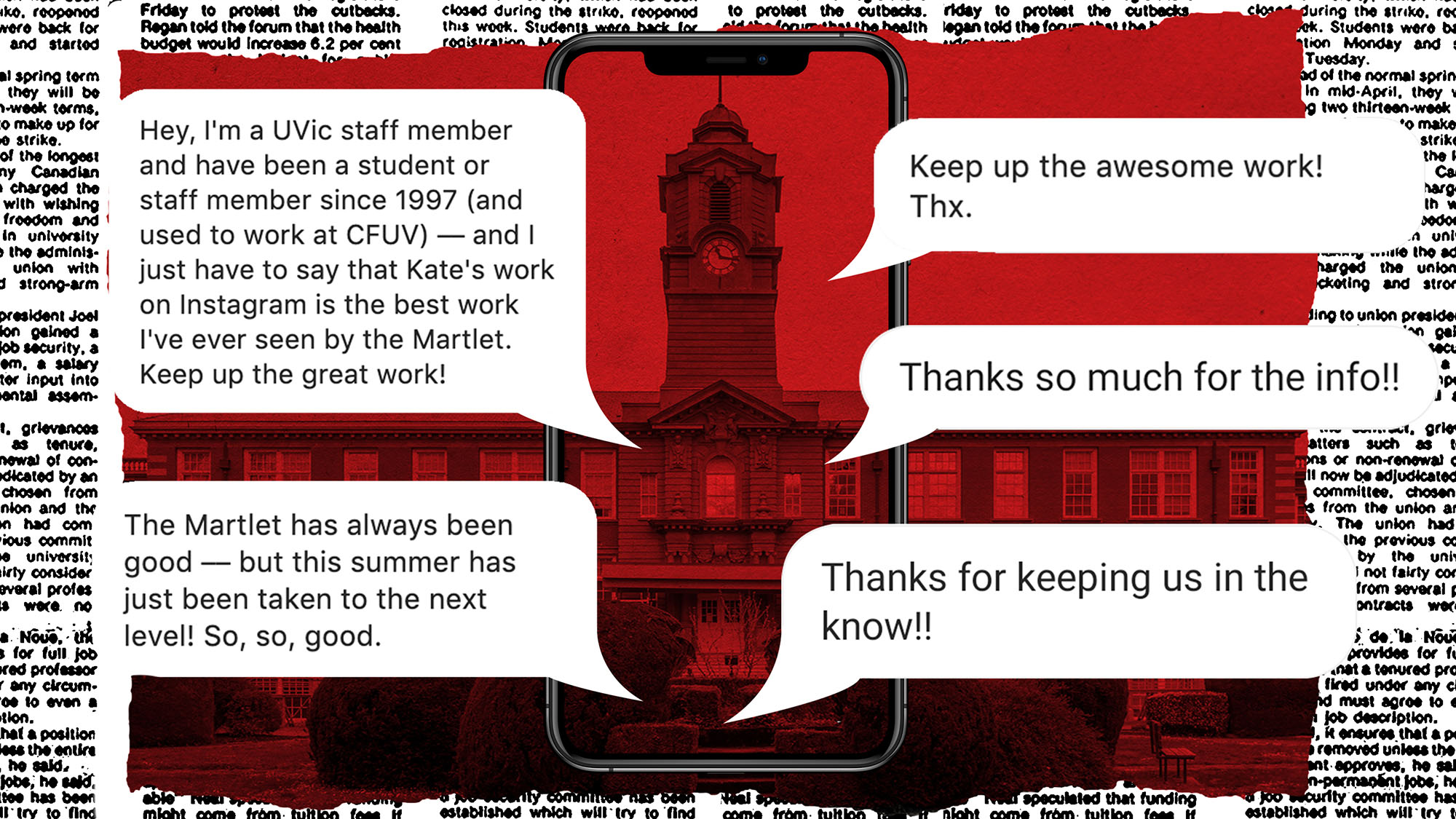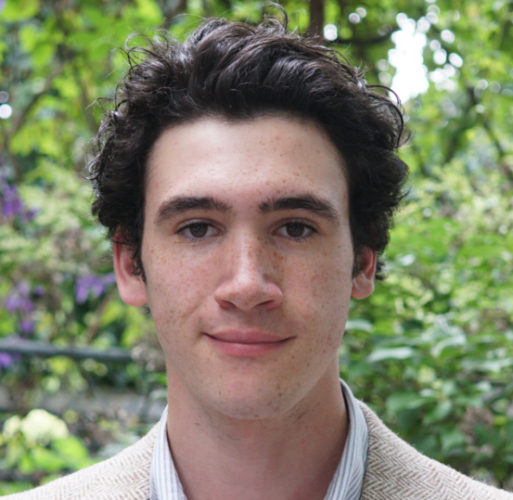Covering campus

caption
Digital collage by Lane Harrison. Images courtesy of the Dalhousie Gazette archive.How student journalists can effectively report on their own schools
In January 2020, a University of Victoria (UVic) board of governors meeting stopped early.
The board had just voted to partly reduce the university’s investments in fossil fuels, and governors could no longer hear their own voices over the chants exploding from the gallery. The motion wasn’t what the students wanted, which was full divestment from fossil fuels.
Kate Korte, today the editor-in-chief of the Martlet, UVic’s independent campus paper, was live-tweeting the meeting. After the crowds left, a UVic communications staffer approached Korte with a rare offer: an interview with university president Jamie Cassels.
“I worked for the Martlet for, I think, two and a half years under him. And I only spoke to him for 15 minutes after a board of governors meeting,” Korte said.
When Korte got that interview offer, it came with a revealing detail. “CTV is here, as well,” the communications person told her. “So they can fit you in with them.”
She wasn’t just tagging along. Korte was a good reporter. She had worked to make that interview happen, introducing herself to the communications team before the meeting. Her editor-in-chief at the time, Emily Fagan, had also built a relationship with the communications team and was invited to interview Cassels while CTV was on site. Korte still thinks the access partly took place because there was a major news organization there.
It would take more time and more work on Korte’s part before the UVic communications department would treat the Martlet with the same respect it showed off-campus media outlets.
The importance of campus papers in Canada
There are 74 independent campus papers in Canada, serving nearly 1.5 million students. By contrast, CTV has 20 local stations across the country airing CTV News at Six. In 2019-2020, CTV News at Six had 1.6 million viewers, almost the same national audience as campus papers, making campus papers an important part of the country’s news landscape.
“We are in an age of increased news poverty,” said Sonya Fatah, an assistant professor at Ryerson University’s School of Journalism who oversees On the Record and the Review of Journalism, the school’s two publications. “Most of that kind of poverty is happening at the local level. And so student publications are, at heart, a form of local journalism,” she said.
Working for a campus paper, according to Liam Afonso, editor-in-chief of the Western Gazette at the University of Western Ontario, is “like having your own little city that you and your reporters can completely specialize in.” Campus papers spend a lot of time reporting on their little cities’ “governments”: the universities and their senior teams.
Access to those administrations varies. The Western Gazette has regular contact with its school’s president through a monthly on-the-record meeting. At St. Thomas University (STU) in Fredericton, N.B., the Aquinian’s editor-in-chief has never interviewed the president; instead, the paper has to rely on interviews with the university’s communications vice president.
As editor-in-chief at the Martlet, one of Korte’s main goals was securing more interviews with senior administration. By creating a relationship between the Martlet and UVic’s communications office, and growing the paper’s online presence through social media-specific content, Korte has set a high standard of reporting for future editors to build upon. These tactics have proven successful. UVic welcomed a new president, Kevin Hall, in November 2020. Korte has interviewed Hall twice in her short time as editor-in-chief.

caption
A collection of direct messages Korte has received about her work for the Martlet. (Screenshots courtesy of Kate Korte. Messages have been edited for length and grammar. Photo of UVic by Michal Klajban.)Improving coverage through compromise
Prior to Korte becoming the Martlet’s editor-in-chief, things were different.
Korte said past editors believed in the tenets of journalism — reporters should never provide questions to subjects prior to an interview; if subjects don’t respond, reporters should keep knocking on their doors until they finally sit down to chat. Korte was interested in making change.
“That was not my approach.”
Within her first few months as editor-in-chief, in the summer months before regular publishing resumed for the school year, she scheduled a coffee walk with the director of the university’s communications office. Korte explained how she wanted to approach the year, and they found a middle ground between the traditions of journalism and the perception-management of public relations.
“I regularly send questions in advance. Because I recognize it’s the only way I’ll get a response,” she said. “And I’ve kind of just, like, accepted that. And it’s made our coverage better.”
But is a relationship the key?
In October 2020, STU’s the Aquinian published a news story about the school’s announcement that winter courses would be delivered online, due to the COVID-19 pandemic. The story was put together fast, leaving less time for interviews than usual.
The Aquinian’s news editor, Hannah Rudderham, who’s now editor-in-chief, called STU’s Jeffrey Carleton.
In the past, the vice president had been reliable for interviews, and he had a good track record of access, always letting the Aquinian know if the university was going to make newsworthy announcements. But on this day, he didn’t pick up. Twice. So Rudderham pressed publish on a story that said, “The Aquinian reached out to STU but received no comment.”
Soon after, Rudderham received an email from Carleton. He was wounded by the simple line that often appears in other student papers. He pointed out to Rudderham that no one can pick up every call. He felt the comment wasn’t fair.
Later, he told Rudderham he’d only been labelled ‘unable to comment’ a few times in his 17 years as vice president at STU.
“It is absolutely essential that there be independent, free-standing, free-thinking media in our democracy and in our society,” said Carleton. “To maintain our democratic structures and to maintain our public accountability. That applies to elected officials, institutions and universities.”
This relationship with Carleton presents the illusion that the Aquinian has great access to the university’s administration and its president. But that’s not always the case.
Carleton said he’ll provide interviews with the president if a story earns it. “A first- or second-year or third-year student or a new reporter of the Aquinian is simply not going to get to ask the president about issues relating to food services in our dining hall,” he said. A story rarely earns the president’s voice, because “most student journalists don’t really understand how the university works,” Carleton said.
According to Sonya Fatah, this relationship is “absolutely not” good access to the university.
“I don’t think the middle man or the person who’s managing communications is a person you ever feel comfortable just hearing from,” Fatah said. “Usually, if you quote them, you’re quoting them because you don’t really have a choice.”
Fatah said that while student journalists may not always have the strongest stories or questions for their president, students are at the university to learn. The president should encourage that by being open to their requests.
Rudderham concurs.
“You want to encourage those writers and editors as much as possible. And to continue to get shut down or turned away?” she said. “It’s, like, a really awful feeling.”
Two goals, one phone
Part of Kate Korte’s strategy to improve the Martlet centres around social media. She said journalists can no longer trust that people will find their way to a paper or look up a publication’s website to seek out the information they need.
“Getting the information to where people are is really, really crucial right now.”
In late August 2021, Korte created an opportunity to advance two goals — improving the Martlet’s coverage of the university and growing its online presence — in one morning.
On Aug. 20, Korte put her phone down in front of her and opened the camera on Instagram. The co-chairs of UVic’s COVID-19 transition team joined her. Together on Instagram Live, they hosted a return-to-campus question period, where students could submit their questions for the upcoming year; Korte served as moderator.
The question period was held on UVic’s Instagram account, which has more than 33,000 followers. This made the event a chance for the Martlet’s own account to grow, allowing more students to be served by its information.
The question period functioned differently than a traditional interview. Students asked things like, “Do I have to wear a mask in class?” a question Korte, as a reporter who’d researched the university’s policies, wouldn’t have asked. But Korte knew a one-on-one interview with the transition team was unlikely, and she wanted students to have the info.
Her efforts haven’t gone unnoticed in the UVic community. At the time of the Instagram Live, the Martlet had 1,500 followers. As of Oct. 24, it has 2,197 — an increase of about 46 per cent.
Good student papers matter
“Hey, I’m a UVic staff member, and have been a student or staff member since 1997,” begins one direct message Korte has received through the Martlet’s Instagram page. “And I just have to say that Kate’s work on Instagram is the best work I’ve ever seen on the Martlet.”
After Korte’s efforts throughout the summer and fall, that direct message is not alone.
Korte keeps many saved in a folder. “A thing to look at on bad days.”
After working tirelessly to improve the paper, the 23-year-old will finish her term as editor-in-chief when the year concludes.
She has created a more comprehensive and formal volunteer training program at the Martlet to prepare the next class of writers and editors. Workshops on social media management, developed by Korte, are a part of the program, ensuring the Martlet’s accounts will remain a hub of information for UVic students.
“That,” she said, “is really important.”
Correction:
About the author

Lane Harrison
Lane Harrison is a fourth-year multimedia journalist from Toronto, Ontario. He works as the editor-in-chief of the Dalhousie Gazette, Dalhousie's...